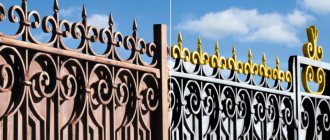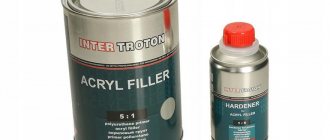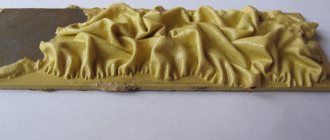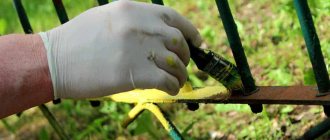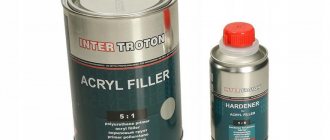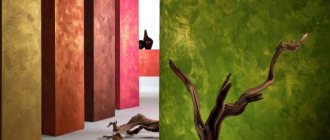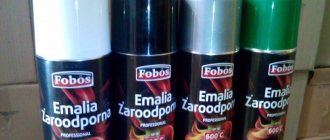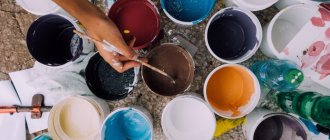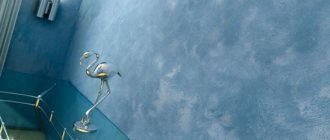Metal roofing materials are always relevant in the construction of residential buildings and outbuildings. The popularity of the coating is explained by its high performance characteristics, long service life and affordable price. The meager choice of color for metal materials can easily be solved by painting with special compounds. Roof paint should not only complement the overall appearance of the house, but also protect the material from weather conditions and corrosion.
Roof painting
Metal roofs can be divided into three groups according to the material used:
- ferrous metal roofs;
- roofs made of galvanized metal;
- roofs made of non-ferrous metals (aluminum, copper, titanium, zinc).
The first and second groups are more accessible and widespread, although noticeably more expensive than slate.
Roofs made of ferrous metal
definitely need to be painted. Typically, oil and alkyd paints are used for these purposes in the old fashioned way. All this, naturally, leads to frequent repainting of the roof.
In order to reliably and permanently protect a metal roof, you should use acrylic roof paints with anti-corrosion additives.
This coating will cost you a little more than oil or alkyd paint, but will last much longer. In addition to the fact that acrylic coating is more durable in atmospheric conditions, it also has an important advantage - high elasticity.
In the case of a metal roof, this is very important, since metals have large linear expansions due to temperature fluctuations.
Oil and alkyd paints have less elasticity than acrylic paints, and they also lose it during the aging process. Eventually, this type of paint will simply begin to peel off the surface of the metal.
Galvanized sheet
- one of the most common roofing materials used for roofing. Galvanized sheet roofs require painting for two reasons.
Firstly, a thin layer of zinc unprotected by paint begins to corrode as a result of aggressive environmental influences (precipitation, salts, exhaust gases, etc.).
Secondly, a painted roof has a decorative appearance and looks more beautiful than an unpainted one. Painting a galvanized roof will extend its life and give it a more pleasant appearance.
In addition, it is always important to pay attention to the consistency of the paint and the surface being painted. For example, galvanized sheet metal cannot be painted with conventional alkyd paint, since as a result of the alkaline reaction of the surface, the alkyd paint will oxidize and lose its adhesive properties. As a result, the paint will peel off from the surface.
To paint galvanized sheet metal, you need to use industrial paints specially designed for such purposes. Galvanized iron has a more passive surface than black iron. Therefore, in this case, specialized paint is required with even greater adhesion and elasticity than in the version with black iron.
One such specialized coating for galvanized roofs is matte acrylic paint for metal roofs Tsikrol , which has excellent adhesion to galvanized surfaces.
The importance of timely completion of work
Even a roof made from the best materials will need repair after a while, so it needs to be cleaned, repaired and painted. This last step is not as complicated and difficult today as it once was.
Not every type of roof can be painted the same. It all depends on the material from which it is made, how much time has passed since its installation or last reconstruction.
Currently, on the shelves of construction stores there is a wide range of paints that are suitable for painting roofs made of different materials. However, not all paint coatings are equally effective. When buying paint, you need to pay attention to the warranty period and weather resistance parameters.
Some experts recommend rubber paints, which are highly resistant to external factors, but lose their shine and quickly acquire a yellow tint.
In turn, alkyd paints are susceptible to washing off; it is not recommended to use them on galvanized roofs, and paints containing vinyl compounds tend to dry quickly in dry and windy weather.
It is important to carry out roof painting work not only for aesthetic reasons in order to update the design of the facade, but also, first of all, for protection from harmful factors, such as:
- UV;
- precipitation;
- wind and snow load;
- constant exposure to microorganisms, fungi and much more.
Which paint to choose?
The choice of paint coating is of great importance, since the strength of the protective coating depends on the correct choice of type, and affects how long the roofing material will last.
Sheet metal (steel) roofing is susceptible to changes in weather conditions (high temperature, frost, precipitation, wind). Any decrease or increase in temperature causes the material to contract and expand. As a result, small microcracks form on it, which become larger over time. Cracks are not resistant to water, which leads to corrosion of the metal after a short time.
Products intended for painting metal are not always synonymous with paints that can be used on roofs. The important thing to remember here is the intense exposure to weather conditions to which it will be exposed. Therefore, it is good to choose paints whose manufacturers label that they are excellent for roofing, indicating the types.
The most commonly used roofing coatings are vinyl and acrylic paints.
They are characterized by good mechanical properties and excellent adhesion to both metal and non-metallic surfaces. Moreover, the coatings created by this type of coatings are plastic, due to which they contract and expand with temperature changes along with the roofing sheet itself. The roof does not crack as is the case with chlorinated rubber paints. And they retain their original color and physical properties without changes for a long period of time.
Therefore, for a durable paint job, you need to choose a roof paint that will withstand the harshest weather conditions, heavy rain, snow and high temperatures.
Different types are used for different surfaces, be it galvanized steel, slate, tiles.
To successfully renew the roof, the paint must have the following properties:
- high flexibility - the roofing sheet is deformed under the influence of temperature changes, so the paint should adhere well to the base and not crack;
- roofs are exposed to solar radiation, the paintwork must be resistant to ultraviolet radiation so that it does not crack or change color;
- versatility is a big advantage, the paint should not be sandblasted, it should withstand application well to corroded, hand-cleaned elements, and apply well to different surfaces;
- be resistant to external conditions - temperature changes throughout the year should not harm the coating;
- have adhesion to steel, seasoned zinc, rust, old paints;
- have high-quality anti-corrosion pigments, anti-corrosion protection;
- have a long service life, durability to external factors;
- have high resistance to ultraviolet radiation, high elasticity, impact resistance;
- dry quickly;
- have a hygiene certificate.
Most often, it is recommended to choose polyurethane paints for painting rather than epoxy resins.
And that's why:
- they form compact, rather hard coatings that can crack;
- epoxy coatings do not have sufficient resistance to ultraviolet radiation - over time they turn yellow and crumble;
- they most often require sandblasting, a perfectly prepared base.
The use of regular metallic paints is highly discouraged due to the fact that once applied and when exposed to strong sunlight, they release harmful chemicals, not to mention that they can quickly lose their color or, worse, they will chafe and chafe. scratch metal almost immediately. Over time, such spots will not be able to be painted over, so the brush marks will not be visible and the appearance of the roof will be ruined.
Acrylic
The most popular group, the properties of which are in a very wide range (paints with low performance characteristics and paints with very good performance parameters). As a rule, they are characterized by durability, a wide color palette, resistance to washing and moisture.
Most often available in 10L and 3L packs, they are ideal for galvanized and other metal surfaces. The product is an excellent anti-corrosion paint for roofs and other metal surfaces, in addition it is a primer and at the same time acts as a thixotropic topcoat (2 in 1). After painting, it creates a durable matte finish with a high level of durability. It performs exceptionally well in changing weather conditions and is resistant to mechanical damage, which is the most important advantage of the product.
When applying it, you do not have to use an additional primer before painting; it adheres perfectly to the surface. It is recommended to thoroughly clean the surface; you can use a special emulsion to degrease the surface.
In order for the roof to remain in its original condition for as long as possible after painting, it is necessary to apply the paint correctly. In accordance with the manufacturer's recommendations, it is worth paying attention to the preparation, priming of the roof and the application itself. Some types, for example, do not require additional primer.
Thanks to the use of this type of paintwork materials, working time will be reduced.
Vinyl
They have lower properties than acrylics (e.g. adhesion, biocorrosion resistance, durability, weather resistance). Their biggest advantage is the ease of application and smooth finishes.
Silicone
They are characterized by high resistance to various atmospheric factors (variable temperatures and ultraviolet rays), the process of self-cleaning of the coating from surface impurities during precipitation and very high resistance to water (in various forms). They exhibit hydrophobic properties and good resistance to biocorrosion (development of fungi, algae, lichens). Unlike acrylic, they have less abrasion resistance and color fastness. Available in a wide range of colors, they are part of the group of façade paints.
What paints are not recommended for painting roofs?
The use of phthalic and acid rubber paints is strongly discouraged for repairing roofing sheets. These are great paints that can be used successfully in many other situations. However, in strong sunlight, which is typical of the environment in which the roofing sheet is exposed, they will peel off quickly. They are also characterized by a lack of resistance to changing temperatures, which will lead to their rapid cracking, poor adhesion to the roofing sheet and, ultimately, insufficient protection.
Painting metal roofs
Before you start painting a metal roof, you need to check the condition of the surface to be painted and, if necessary, replace rusted sheet metal, downpipes, gutters, drains, etc. You will also need to calculate the area of the surface to be painted to find out the paint consumption.
Before painting a metal roof, its surface should be cleaned of dirt, rust and old peeling paint. Removers are used to remove old paint. Rust is usually removed with steel brushes or using chemicals (rust converter).
The rust converter is applied to cleaned and degreased surfaces using a brush. You should work with rubber gloves and safety glasses. You can paint the roof only after the composition has completely dried, that is, after 4-5 days.
A steel roof rusts not only from the outside, but also from the inside (that is, from the attic side). This usually happens between the sheathing. The part of the roof that lies on the sheathing does not rust, as it is protected by wood (boards).
Rust occurs because warm air passes through the ceilings into the attic. It is known from practice that it is often between the sheathing that there are rusted places, but sometimes they are also located under the sheathing.
To protect the roof from rusting, the steel between the sheathing should be cleaned of rust with a hard brush or soft steel brush and painted with anti-corrosion paint for metal roofs (roof painting). This will extend the life of your metal roof.
If the metal roof begins to rust, then you need to, without wasting time, remove the rust and paint the surface with a special protective paint Tsikrol
.
The metal roof is painted with large brushes. The technique for painting a roof is the same as for painting walls and ceilings. When painting, the paint is shaded along the slope. First of all, the roof slope is painted, and then work continues from the ridge to the slopes.
When working on the roof, you should wear felt boots or ordinary shoes, but with attached felt soles that do not slip on the roofing steel and do not destroy the freshly applied paint layer.
Necessary tools for work
To paint the roof, it is recommended to use all available tools used in such cases:
- Brushes. Needed for painting small parts, transitions and joints. When treating the roof, it is recommended to use brushes with a diameter of 6-6.5 centimeters made of horsehair, which leaves fewer streaks.
- Rollers. Used for painting large and hard-to-reach areas. It is recommended to take collapsible rollers so that you can quickly update the tool, and with fine pile.
- Spray. This tool ensures uniform distribution of paint over the surface, thereby reducing material consumption. Sprayers also speed up the work.
It is recommended to wear shoes with felt soles. This material prevents slipping and does not harm the fresh coating.
Roof paint Tsikrol
Special paint for galvanized roofs Tsikrol
is a matte acrylic paint containing active anti-corrosion additives in organic solvents.
Roof paint is intended for exterior painting of steel, aluminum and galvanized surfaces. The paint is used to protect any metal roofs, roofing iron, gutters, protective sheets, downpipes, gutters and other metal structures.
Paint for galvanized roofs has high hiding power and light fastness, and has excellent water resistance and weather resistance characteristics. The paint is easy to use and has excellent adhesion to the surface being painted.
Cyclol
- the best option for repair painting of galvanized roofs. A significant advantage of the paint is that it does not require prior priming of the surface and is applied in one layer.
Roof paint Tsikrol provides long-term protection of the metal surface from weathering, humidity, sun, rain, salty air, etc. Roofing paint does not fade, dries quickly, significantly extends the service life of galvanized roofs and gives them an attractive appearance.
Requirements for paint for roofing work
Roofing paint must meet the following requirements:
- resistance to precipitation and other adverse factors;
- sufficient elasticity;
- the ability to expand when heated without losing its original properties;
- uniform color that does not fade under the influence of the sun;
- Suitable for various types of roofing materials, including ferrous metal.
An important quality of roofing paint is the presence of anti-corrosion properties. To treat the roof, it is recommended to use materials that can be applied at low (but not negative) temperatures.
Expert opinion
Zakharova Irina Yurievna
Cleaning professional with 15 years of experience. Our best expert.
Ask a Question
When repairing the roof, quick-drying paint should be used. In this case, work can be carried out more quickly.
Roof paint Tsikrol 2sh
Tsikrol 2sh paint does an excellent job of protecting galvanized steel surfaces in aggressive environments.
Retains the protective and decorative qualities of the finish coating in temperate and cold climates for 12 years, and in tropical and marine climates for up to 7 years!
The paint dries quickly - only 2 hours, has a low consumption (1 kg per 9-12 sq.m., layer thickness 25-35 microns) and can be applied both to a clean galvanized surface and to those with traces of corrosion.
Why do you need roof painting?
Metal roofing is made from galvanized steel coated with a protective oil layer. This impregnation is enough for about 10-12 months of operation, after which it is washed out under the influence of precipitation and ultraviolet radiation. Therefore, to properly protect the metal from adverse environmental conditions, the roof must be coated with paint. This processing allows:
- prevent rust and subsequent destruction;
- improve the aesthetic qualities of the roof;
- reduce subsequent costs for repairs or replacements.
It is recommended to paint the roof immediately after installation (weather permitting).
Previously painted galvanized roof
If the old roofing coating is peeling a lot, this means that it does not have sufficient adhesion to the substrate. In this case, you need to clean off the rust and flaking paint.
Sand the joint between the cleaned area and the durable paintwork with sanding paper until a smooth transition is formed. Then apply paint for metal roofs Tsikrol
in one layer.
Metal roof: painting the roof - on the website krasko.ru
.
You can find out more detailed information about protecting and painting metal roofs (metal roof, paint for a metal roof, painting a metal roof) on the website.
Rubber acrylic paint
One of the varieties of acrylic paints is rubber. The composition is made from environmentally friendly materials. It is absolutely harmless to humans and animals. The substance can be diluted with water to obtain optimal density. One of the main advantages of the composition is its flexible, breathable structure, which allows the coating to maintain its integrity after temperature changes and heavy precipitation.
In order for the coating layer to remain undamaged for many years, it is necessary to choose the right coloring composition. Acrylic rubber paints differ in the type of material on which they should be applied. Painting compositions available:
- slate;
- wood;
- bitumen roll materials;
- metal tiles;
- galvanized sheets.
The paint is chosen depending on the roofing material. You should not buy a compound to work on another surface. The composition is developed based on the structure and specifics of the working surface. So, metal coatings contain more anti-corrosion components, and materials for wood contain substances against pests and rot. Properly selected coatings will protect the roof from bad weather and ultraviolet radiation and allow you to save money.
Rubber paints have high adhesion. They can be classified as deep penetration paints. After application, they form a durable flexible film on the surface that does not delaminate over time. The substance has a water-repellent layer that protects the metal from precipitation, sun and other negative phenomena. The main advantages of the composition are the following characteristics:
- long service life (about 10 years);
- increased waterproofing;
- high level of adhesion to the working surface;
- maintaining technical indicators even with large temperature differences;
- resistance to mechanical damage;
- rich color palette.
Among other things, the composition does not crack over time, which cannot be said about alkyd and oil compositions.
Types of paints for metal roofing
Ferrous metals and galvanized steel are the most common types of roofing metal, and there are several types of paint available for them:
- oil paint;
- acrylic paints;
- special paints with anti-corrosion effect.
The cheapest of all paints is oil paint. Just before you buy oil paint for the roof, you need to weigh everything a hundred times. It is not as durable, and despite being cheap, it will require repainting the roof much more often than other types. And this is almost more expensive, so the savings are quite dubious.
How to paint the iron roof of a house
Metal roofing is often installed on country houses. In order to protect it from the harmful effects of the external environment and increase its service life, the metal is coated with paint.
But not any paint can be used to paint an iron roof, so it often arises as to which paint and varnish material would be better for painting in order to improve the quality characteristics and improve the appearance of the roof.
Preparing the surface for painting
To obtain a high-quality protective layer, the surface must be carefully prepared. There are certain types of paints that can be applied against rust, but you need to understand that miracles do not happen, and an untreated sheet will continue to rust. To prepare a previously painted surface, chemical removers for old paint are used. It is better to replace especially damaged or suspicious areas of the roof with new ones or additionally treat them with rust converters. They are applied to the roof, but you can start painting no earlier than after 3-4 days.
Cleaning and preparing the roof is a long and grueling process, but it cannot be done without it, since the most important thing is the longevity of the paint, and if the surface is poorly prepared, even the most expensive paint can withstand a year and a half, and then the whole operation will have to be repeated again.
With high-quality painting, the service life of the protective layer will ensure an excellent appearance and protection of the roof from corrosion for a period of 10 years, and it will be possible to paint the roof earlier only for the purpose of changing the design.
Construction of houses
To protect an iron roof from the harmful effects of precipitation, sunlight and industrial pollution, it is customary to paint it. Painting will not only extend the life of the roof, but also make it more attractive. But not every paint and varnish composition is suitable for this task. Therefore, many people are interested in how to paint an iron roof so that it retains its original appearance and excellent properties for many years.
Content:
The need to paint an iron roof
Metal roofing sheets are one of the materials that are offered in a wide range on the market, and deservedly enjoy wide popularity among developers. Metal roofing is made from non-ferrous metal, galvanized or rough steel and aluminum (copper is used very rarely due to its high cost). The most popular is a roof that is covered with galvanized steel: rectangular and wavy sheets or profiles.
The popularity of iron roofing is facilitated by such properties of the roofing material as high durability and strength. In addition, it is immune to fire. An important advantage of metal roofing is its unpretentiousness, which is expressed in preventing the growth of various harmful algae and mold.
This material also demonstrates excellent results under significant external influences, be it heavy hail, snow or rain, low or high temperatures, strong gusts of wind, even hurricanes and earthquakes. The metal coating reflects the sun's rays, which will help you significantly reduce the cost of cooling your roof.
It is known that a metal roof is much more expensive than most traditional materials, but the costs of its installation are fully recouped during operation. Metal roofs can last over 60 years without repair, but traditional roofing materials require repairs after 15 to 20 years.
To ensure maximum durability and reliability of the metal covering, the iron roof of the house must be painted. Galvanized sheet metal that is not coated with a special compound is exposed to environmental influences, and the thin layer of galvanized coating begins to corrode.
Rapid wear of the metal coating is the result of exposure to several factors: sunlight, oxygen, precipitation, temperature changes, salts, dust, sand, exhaust gases and other industrial air pollutants. For example, when carbon dioxide combines with moisture, rainwater oxidizes, which provokes the destruction of the coating. Sand and dust contaminate the surface and wear away the paint film. In winter and spring, mechanical impact is additionally exerted by snow and the process of its melting.
After 20 years of service, gray streaks may appear on the roof, which are the first signs of corrosion. If the owner overlooks and allows rust to appear on the roof, then no subsequent painting will prevent this or stop the process of decomposition and oxidation of iron. Subsequently, rust will spread very quickly, corroding the iron so much that the roof may even leak in places.
The second factor why an iron roof should be painted is appearance. Unpainted steel has an unfinished, unpresentable appearance. It is recommended to paint a new roof after waiting several months after installation: during this time a film of zinc salts will form on the surface of the sheet, improving the adhesion of the coating.
